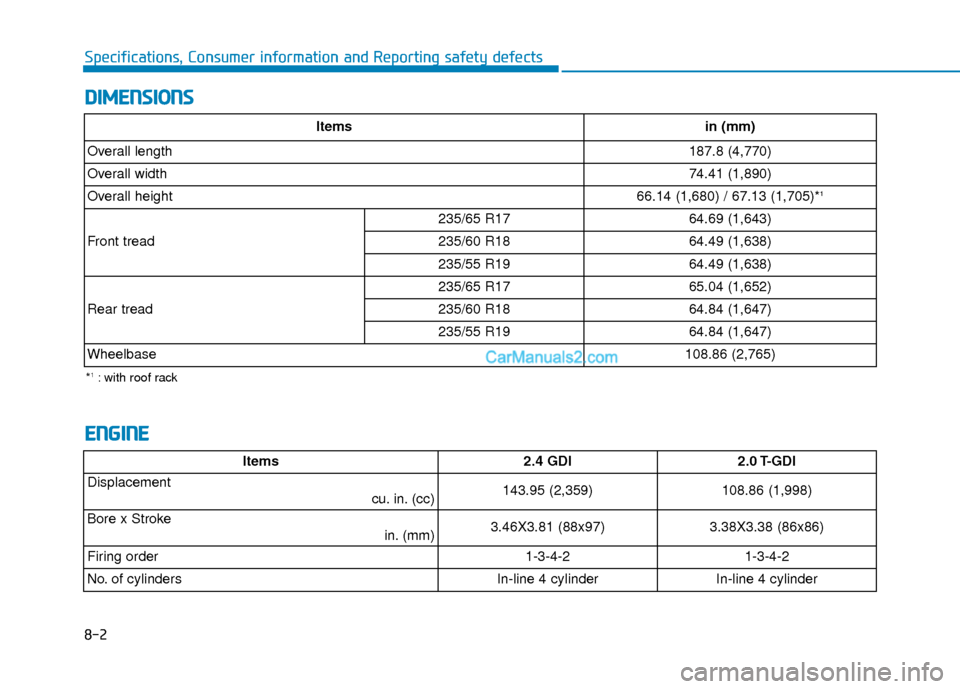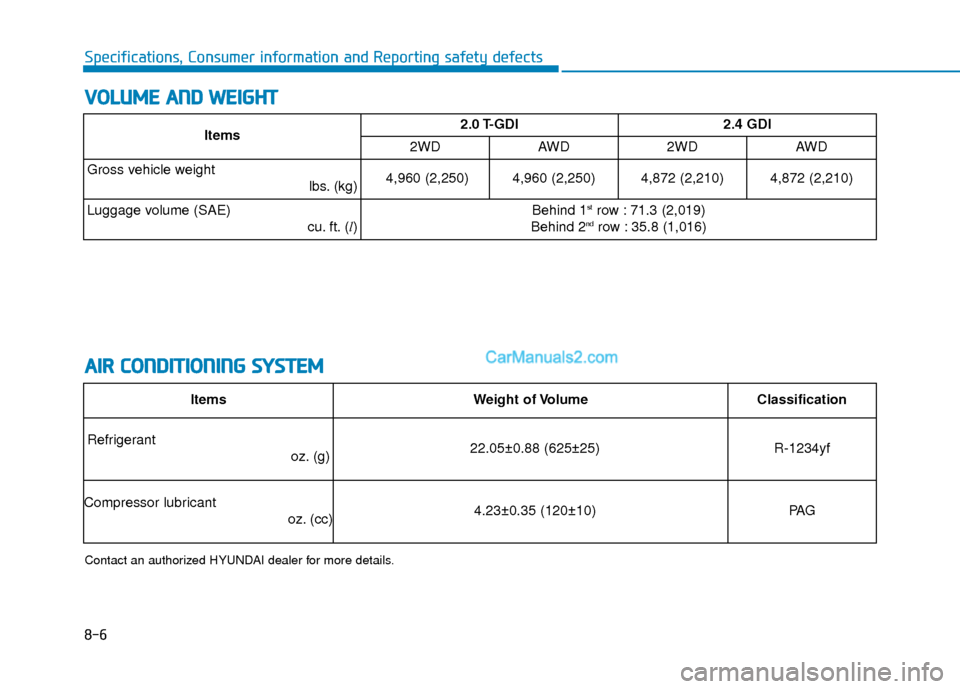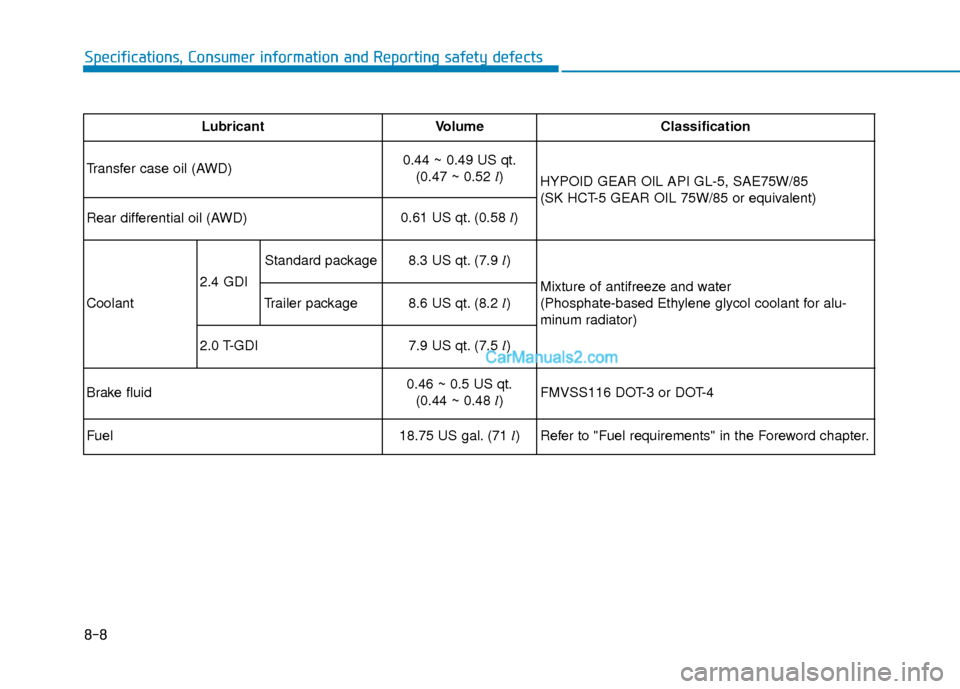Hyundai Santa Fe 2020 Owner's Manual
Manufacturer: HYUNDAI, Model Year: 2020, Model line: Santa Fe, Model: Hyundai Santa Fe 2020Pages: 557, PDF Size: 19.29 MB
Page 531 of 557

888
Specifications & Consumer information
8
Specifications, Consumer information and Reporting safety defects
8
Dimensions ..............................................................8-2
Engine ......................................................................8-\
2
Bulb Wattage ..........................................................8-3
Tires and Wheels ...................................................8-5
Volume and Weight ................................................8-6
Air Conditioning System........................................8-6
Recommended Lubricants and Capacities ..........8-7
Recommended SAE Viscosity Number ........................8-9
Vehicle Identification Number (VIN) .................8-10
Vehicle Ccertification Label................................8-10
Tire Specification and Pressure Label .............8-11
Engine Number .....................................................8-11
Refrigerant Label .................................................8-11
Consumer Information .........................................8-12
Reporting Safety Defects ...................................8-13
Page 532 of 557

D
DI
IM
M E
EN
N S
SI
IO
O N
NS
S
8-2
Specifications, Consumer information and Reporting safety defects
E
EN
N G
GI
IN
N E
E
Items 2.4 GDI2.0 T-GDI
Displacement
cu. in. (cc)143.95 (2,359)108.86 (1,998)
Bore x Stroke in. (mm)3.46X3.81 (88x97)3.38X3.38 (86x86)
Firing order1-3-4-21-3-4-2
No. of cylindersIn-line 4 cylinderIn-line 4 cylinder
*1: with roof rack
Itemsin (mm)
Overall length187.8 (4,770)
Overall width74.41 (1,890)
Overall height66.14 (1,680) / 67.13 (1,705)*1
Front tread
235/65 R1764.69 (1,643)
235/60 R1864.49 (1,638)
235/55 R1964.49 (1,638)
Rear tread
235/65 R1765.04 (1,652)
235/60 R1864.84 (1,647)
235/55 R1964.84 (1,647)
Wheelbase108.86 (2,765)
Page 533 of 557

B
BU
U L
LB
B
W
W A
AT
TT
TA
A G
G E
E
88
Specifications, Consumer information and Reporting safety defects
Light Bulb Bulb Type Wattage
FrontType A
Headlamp
Low HB3 60
High HB3 60
Turn signal lamp PY28W28
Type B
Headlamp Low/High LED LED
Low/High (sub) LED LED
Turn signal lampPY28W28
Side marker lamp LEDLED
Parking lamp LEDLED
Daytime Running Lamp (DRL) LEDLED
Fog lamp Type A
H835
Type B LEDLED
Rear Type A
Tail lamp
W5W5
Tail/Stop lamp P21/5W5/21
Side marker lamp W5W5
Type B
Tail lamp LEDLED
Tail/Stop lamp LEDLED
Side marker lampLEDLED
Turn signal lamp PY21W21
Back up lamp W16W16
License plate lamp W5W5
High mounted stop lamp LEDLED
8-3
Page 534 of 557

8-4
Specifications, Consumer information and Reporting safety defects
Light BulbBulb TypeWattage
InteriorMap lamp
Type A FESTOON 10
Type B LED LED
Room lamp Type A FESTOON 10
Type B
LEDLED
Vanity mirror lampFESTOON5
Luggage compartment lamp FESTOON10
Page 535 of 557

When replacing tires, use the same size originally supplied with the vehicle.
Using tires of a different size can damage the related parts or not work properly.
CAUTION
T
T I
IR
R E
ES
S
A
A N
N D
D
W
W H
HE
EE
EL
LS
S
8-5
88
Specifications, Consumer information and Reporting safety defects
• It is permissible to add 3 psi to the standard tire pressure specification if colder temperatures are expect-
ed soon.
Tires typically loose 1psi (7kPa) for every 12°F temperature drop. If extreme temperature variations are
expected, recheck your tire pressure as necessary to keep them properly inflated.
An air pressure generally decreases, as you drive up to a high-altitude area above sea level. Thus, if you plan to drive a high-altitude area, check the tire pressures in advance. If necessary, inflate them to a prop-
er level. (Air inflation per altitude : +2.4 psi/1 mile)
NOTICE
Item Tire Size Wheel Size Cold tire inflation pressure, kPa (psi)
Wheel Lug Nut
Torque
kgf·m (lbf·ft, N·m)
Front
Rear
Full size tire 235/65 R17 7.0J X 17
240 (35)240 (35)
11~13
(79~94,107~127)
235/60 R18 7.5J X 18
235/55 R19 7.5J X 19
Compact spare tire T165/90R 17 4.0T X 17 420 (60)
Page 536 of 557

8-6
Specifications, Consumer information and Reporting safety defects
V
VO
O L
LU
U M
M E
E
A
A N
N D
D
W
W E
EI
IG
G H
H T
T
A
A I
IR
R
C
C O
O N
ND
DI
IT
T I
IO
O N
NI
IN
N G
G
S
S Y
Y S
ST
T E
EM
M
Contact an authorized HYUNDAI dealer for more details.
Items2.0 T-GDI2.4 GDI
2WDAWD2WDAWD
Gross vehicle weight
lbs. (kg)4,960 (2,250)4,960 (2,250)4,872 (2,210)4,872 (2,210)
Luggage volume (SAE)cu. ft. (l)Behind 1strow : 71.3 (2,019)
Behind 2ndrow : 35.8 (1,016)
ItemsWeight of VolumeClassification
Refrigerant oz. (g) 22.05±0.88 (625±25)R-1234yf
Compressor lubricant oz. (cc) 4.23±0.35 (120±10)PA G
Page 537 of 557

8-7
88
Specifications, Consumer information and Reporting safety defects
To help achieve proper engine and powertrain performance and durability, use only lubricants of the proper quality.
The correct lubricants also help promote engine efficiency that results in improved fuel economy.
R RE
EC
CO
O M
M M
ME
EN
N D
DE
ED
D
L
L U
U B
BR
RI
IC
C A
A N
N T
TS
S
A
A N
N D
D
C
C A
A P
PA
A C
CI
IT
T I
IE
E S
S
LubricantVolume Classification
Engine oil *
1*2(drain and refill)
Recommends
2.4 GDI5.07 US qt. (4.8 l)
SAE 5W-20 / API Latest (ILSAC Latest)
2.0 T-GDI5.07 US qt. (4.8 l)SAE 5W-30 / API Latest (ILSAC Latest) or
ACEA A5/B5
Automatic transmission fluid
2.4 GDI6.86 US qt. (6.5
l) MICHANG ATF SP-IV, SK ATF SP-IV,
NOCA ATF SP-IV, HYUNDAI genuine ATF
SP-IV or other brands meeting the above
specification approved by HYUNDAI Motor
Co.
2.0 T-GDI7.09 US qt. (7.0 l)
*1: Refer to the recommended SAE viscosity numbers on the 9 page.
*2: Engine oils labeled Energy Conserving Oil are now available. Along with other additional benefits, they contribute to fuel econ -
omy by reducing the amount of fuel necessary to overcome engine friction. Often, these improvements are difficult to measure
in everyday driving, but in a year's time, they can offer significant cost and energy savings.
Page 538 of 557

8-8
Specifications, Consumer information and Reporting safety defects
LubricantVolumeClassification
Transfer case oil (AWD)
0.44 ~ 0.49 US qt. (0.47 ~ 0.52 l) HYPOID GEAR OIL API GL-5, SAE75W/85
(SK HCT-5 GEAR OIL 75W/85 or equivalent)
Rear differential oil (AWD)
0.61 US qt. (0.58 l)
Coolant 2.4 GDI
Standard package8.3 US qt. (7.9
l)
Mixture of antifreeze and water
(Phosphate-based Ethylene glycol coolant for alu-
minum radiator)
Trailer package8.6 US qt. (8.2 l)
2.0 T-GDI
7.9 US qt. (7.5 l)
Brake fluid
0.46 ~ 0.5 US qt. (0.44 ~ 0.48 l) FMVSS116 DOT-3 or DOT-4
Fuel18.75 US gal. (71 l)Refer to "Fuel requirements" in the Foreword chapter.
Page 539 of 557

8-9
88
Specifications, Consumer information and Reporting safety defects
Recommended SAE viscosity
number
Always be sure to clean the area
around any filler plug, drain
plug, or dipstick before check-
ing or draining any lubricant.
This is especially important in
dusty or sandy areas and when
the vehicle is used on unpaved
roads. Cleaning the plug and
dipstick areas will prevent dirt
and grit from entering the
engine and other mechanisms
that could be damaged.
CAUTION
Temperature Range for SAE Viscosity Numbers
Temperature -30 -20 -10 0 10 20 30 40 50
-10 0 20 40 60 80 100 120
Engine Oil
2.4 GDI *1
2.0 T-GDI *2
°C
(°F)
*1: For better fuel economy, it is recommended to use the engine oil of a viscosity grade SAE 5W-20. However, if the engine oil is not
available in your country, select the proper engine oil using the
engine oil viscosity chart.
*
2: For better fuel economy, it is recommended to use the engine oil of a viscosity grade SAE 5W-30. However, if the engine oil is not
available in your country, select the proper engine oil using the
engine oil viscosity chart.
0/5W-30, 5W-40
10W-30
15W-40
20W-50
10W-30
5W-20, 0/5W-30
Engine oil viscosity (thickness) has an effect on fuel economy and cold
weather operating (engine start and engine oil flowability). Lower viscosity
engine oils can provide better fuel economy and cold weather performance,
however, higher viscosity engine oils are required for satisfactory lubrication
in hot weather.
Using oils of any viscosity other than those recommended could result in
engine damage.
When choosing an oil, consider the range of temperature your vehicle will be
operated in before the next oil change. Proceed to select the recommended
oil viscosity from the chart.
Page 540 of 557

8-10
Specifications, Consumer information and Reporting safety defects
The vehicle identification number
(VIN) is the number used in register-
ing your car and in all legal matters
pertaining to its ownership, etc.
The number is punched on the floor
under the passenger seat. To check
the number, open the cover. The VIN is also on a plate attached
to the top of the dashboard. The
number on the plate can easily be
seen through the windshield from
outside.
The vehicle certification label attached
on the driver's side center pillar gives
the Vehicle Identification Number
(VIN).
V V
E
EH
H I
IC
C L
LE
E
I
ID
D E
EN
N T
TI
IF
F I
IC
C A
A T
TI
IO
O N
N
N
N U
U M
M B
BE
ER
R
(
( V
V I
IN
N )
)
OTM088008L
■ VIN label
OTMA088011
OTM088001
V
VE
EH
H I
IC
C L
LE
E
C
C E
E R
R T
TI
IF
F I
IC
C A
A T
TI
IO
O N
N
L
L A
A B
BE
EL
L